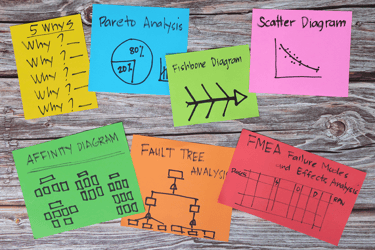The Packaging Industry's Sustainability Challenge: Why ERP Systems Are Essential for Success A straightforward guide to navigating sustainability regulations across folding carton, flexible...
ERP efficiency in the packaging industry: The importance of gap analysis
In the packaging and converting industry, customers can express frustrations with their Enterprise Resource Planning (ERP) or management systems after several years of use.
Comments like “the system does not meet our needs” or “we need to look for another system that evolves as we do” can be common.
These signs indicate that the original system implementation is deteriorating, a problem that can arise for several reasons:
- Changes in requirements
As the demand in the packaging industry evolves, system requirements also change. The original implementation may no longer meet current needs, leading to parallel work practices or searching for alternative solutions. - Maintenance failures
Innovation is constant in the packaging industry. Failure to update the system can lead to deterioration over time. These updates include security updates, bug fixes, performance optimizations, and the inclusion of new functionalities essential to keeping up with industry demands. - Technological obsolescence
With rapid advancements in packaging and converting technology, technological obsolescence is a real threat. A lack of investment in technological infrastructure can render the system implementation outdated. - Poor data management
In packaging production, where precision is crucial, poor management of the data feeding the system can result in data integrity issues and system performance problems, compromising quality and efficiency.
To mitigate these problems, it is crucial to invest in periodic reviews of the implemented system's processes and functionalities. This is necessary since the company's needs change, and systems must also be enhanced to ensure they continue to meet market demands.
The role of user feedback in system evolution
User feedback is a critical component in ensuring that ERP and management systems remain effective over time. Engaging with employees across all levels, ranging from shop floor operators to executives, can provide valuable insights into system shortcomings and opportunities for improvement. Regular user feedback sessions or surveys help uncover pain points, inefficiencies, and gaps in system functionality.
Furthermore, integrating this feedback into your system review process ensures that updates and enhancements are aligned with real-world user needs, fostering greater adoption and satisfaction. A robust feedback loop can transform frustrations into actionable improvements, driving both user productivity and system relevance.
Gap analysis: Identifying and overcoming challenges
Gap analysis is a process aimed at identifying and analyzing the differences ("gaps") between an organization's current state and its desired state. Incorporating a Strengths, Weaknesses, Opportunities, and Threats (SWOT) framework into the gap analysis can help identify not only areas of improvement but also leverage strengths and capitalize on opportunities while mitigating risks and addressing weaknesses. Conducting a gap analysis on the management system allows organizations to identify areas for improvement, implement corrective and preventive actions, and strengthen internal system knowledge to meet the company's current needs, promoting effectiveness and compliance with the current reality.
During a gap analysis, some crucial points are analyzed:
- Current performance: Evaluation of current performance against established goals and objectives.
- Processes and controls: Review to ensure the effectiveness of the management system implementation.
- Human resources: Assessment of team skills regarding the system and training needs.
- Technology and infrastructure: Analysis of technological infrastructure and the need for updates to ensure system availability and security.
Success after the gap analysis
After the gap analysis stage, it is vital to observe some points to ensure continued success:
- Compliance with standards and regulations: Verification of the management system's compliance with current industry standards and legal regulations.
- Goals and objectives: The team must clearly define its goals and understand whether the system can support them.
- Internal communication: Review and define internal communication to ensure everyone understands the goals and objectives.
- Top management commitment: Ensure all managers are aware of their responsibilities within the workflow and provide appropriate leadership and support. Assigning dedicated project managers ensures that improvement initiatives are executed efficiently, resources are allocated effectively, and stakeholders remain aligned with the goals.
- Performance and monitoring: Ensure all performance indicators are compliant and understood by everyone involved in the process.
- Strategic planning: Align improvement initiatives with the organization’s long-term strategic plan to ensure the system supports future growth and market demands.
Future-proofing your ERP system
The rapid pace of technological advancements and shifting market demands in the packaging and converting industry underscore the importance of future-proofing your ERP system. Organizations can ensure long-term adaptability by adopting scalable, modular systems that can evolve alongside business needs. By defining clear future states, companies can proactively design systems and processes that align with their vision for growth, innovation, and market leadership. Staying informed about industry trends and innovations allows companies to anticipate future challenges and implement proactive measures.
Additionally, investing in infrastructure upgrades, ensuring system interoperability with emerging technologies, and maintaining a commitment to regular system reviews and updates are critical strategies for safeguarding the utility and relevance of your ERP system over time.
Conclusion
By conducting a gap analysis, organizations can develop effective strategies to address identified gaps, improve performance, and advance toward their strategic objectives without investing in other solutions, strengthening the system and the knowledge already implemented within the business. Leveraging gap analysis tools ensures a structured approach to identifying and addressing challenges, providing actionable insights that drive continuous improvement.
Our extensive work with packaging companies has demonstrated the value of gap analysis in identifying specific areas where their current ERP and management systems fall short. Through this process, we've helped clients pinpoint inefficiencies, uncover training needs, and update technological infrastructures.
The result is a significant enhancement in operational performance and a more robust alignment with strategic goals. This approach leverages the existing system and expertise within the business, providing a cost-effective pathway to continuous improvement and competitive advantage.
Frequently asked questions
1. How often should we perform a gap analysis on our ERP or management system?
It's recommended to conduct a gap analysis at least annually or whenever significant operational or market changes occur. This helps ensure your system remains aligned with your evolving business needs.
2. What are some warning signs that our ERP system needs a review?
Common indicators include increasing reliance on manual processes, frequent system workarounds, user dissatisfaction, and difficulty keeping up with industry compliance requirements.
3. How long does a gap analysis typically take?
The duration can vary depending on the complexity of your system and organization, but most analyses take between a few weeks to a couple of months, including data collection, assessment, and reporting.
4. Can we conduct a gap analysis internally, or do we need external consultants?
While it’s possible to perform a gap analysis internally, engaging external consultants can bring an unbiased perspective, industry-specific expertise, and proven methodologies to the process.
5. What should we prioritize after identifying gaps in our system?
Priorities depend on the severity and impact of the gaps, but common focus areas include addressing compliance issues, enhancing user training, upgrading outdated technology, and optimizing inefficient processes.




